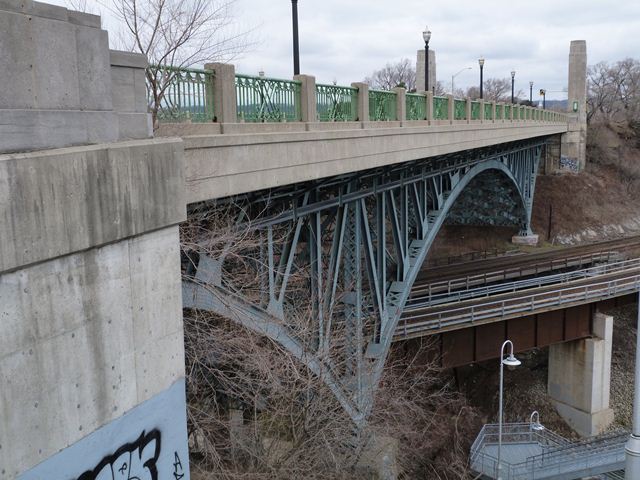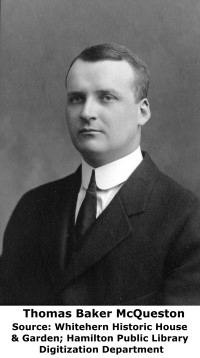We Recommend:
Bach Steel - Experts at historic truss bridge restoration.
BridgeHunter.com Phase 1 is released to the public! - Visit Now
Thomas B. McQuesten High Level Bridge
High Level Bridge

Primary Photographer(s): Nathan Holth
Bridge Documented: December 25, 2012
Hamilton: Hamilton City, Ontario: Canada
1932 By Builder/Contractor: Hamilton Bridge Company of Hamilton, Ontario and Engineer/Design: James, Proctor, and Redfern of Toronto, Ontario
1987
Not Available
365.0 Feet (111.3 Meters)
54 Feet (16.46 Meters)
3 Main Span(s)
Not Applicable

View Information About HSR Ratings
Bridge Documentation
View An Archived Article Discussing This Bridge's History
This landmark bridge is one of the most unique and significant bridges in this area. An impressive cantilever deck truss, this bridge is technologically significant as an excellent surviving example of this complex bridge type. The bridge contains a carefully concealed suspended span in the center of the bridge that blends in with the rest of the truss. This is a bridge that was designed to be a beautiful and iconic gateway structure. The graceful arch shapes of the cantilever truss help accomplish this. The bridge also features four massive limestone faced pylons at each corner, with coat of arms sculptures and decorative patterns cast into them. These pylons have openings in them that were designed to accept statues that were never made, so these remain empty to this day. The railings on this bridge are a unique ornate design of metal panels and concrete posts that at the end of the bridge terminate in a short second of solid concrete railing, which is also decoratively designed. Even period utilitarian features of the bridge contribute to this bridge's aesthetic qualities. The bridge's many riveted built-up beams contain v-lacing and lattice which was designed to hold the parts of the built-up beams together. However, the v-lacing and lattice also give the members an airy open appearance and they also contribute to the beautifully complex geometric art that the trusses of this bridge display.
This bridge retains good overall historic integrity. The decorative elements of the bridge including railing remain as built. The truss in general is largely unaltered from its original design and appearance, although the suspended span of the truss appears to have been repaired extensively. Numerous rivets have been replaced with bolts in this area
Originally named the High Level Bridge, this bridge was renamed to honor Thomas Baker McQuesten who was the Minister of Highways and a resident of Hamilton that played a major role in making this bridge a reality. The bridge is today a recognized heritage bridge and it has been rehabilitated in the past with a focus on preserving its heritage value.
This bridge is located at an area that has been home to many bridges, some of which remain standing today, some of which no longer remain. Three of the bridges remaining today, including the High Level Bridge, have heritage value. One interesting feature of the High Level Bridge is it actually crosses over another heritage bridge, the Desjardins Canal Railway Bridge, which passes under the bridge at an angle. This railway bridge is older than the current High Level Bridge. The third heritage bridge is the nearby low level Longwood Bridge, a concrete arch bridge that was built just prior to the construction of the current High Level Bridge, and helped serve as a detour during its construction.
The previous High Level Bridge at this location was an impressive spandrel braced metal deck arch with a trussed rib. The bridge also featured deck truss approach spans. Two images of this bridge are shown below.
Information and Findings From Hamilton's Heritage Bridge Structure Assessment ReportAsset/Bridge ID: 310-1148 Notes: This structure scored exceptionally well on the heritage evaluation. The age, materials, |
![]()
Photo Galleries and Videos: Thomas B. McQuesten High Level Bridge
Bridge Photo-Documentation
Original / Full Size PhotosA collection of overview and detail photos. This gallery offers photos in the highest available resolution and file size in a touch-friendly popup viewer.
Alternatively, Browse Without Using Viewer
![]()
Bridge Photo-Documentation
Mobile Optimized PhotosA collection of overview and detail photos. This gallery features data-friendly, fast-loading photos in a touch-friendly popup viewer.
Alternatively, Browse Without Using Viewer
![]()
Maps and Links: Thomas B. McQuesten High Level Bridge
Coordinates (Latitude, Longitude):
Search For Additional Bridge Listings:
Additional Maps:
Google Streetview (If Available)
GeoHack (Additional Links and Coordinates)
Apple Maps (Via DuckDuckGo Search)
Apple Maps (Apple devices only)
Android: Open Location In Your Map or GPS App
Flickr Gallery (Find Nearby Photos)
Wikimedia Commons (Find Nearby Photos)
Directions Via Sygic For Android
Directions Via Sygic For iOS and Android Dolphin Browser




